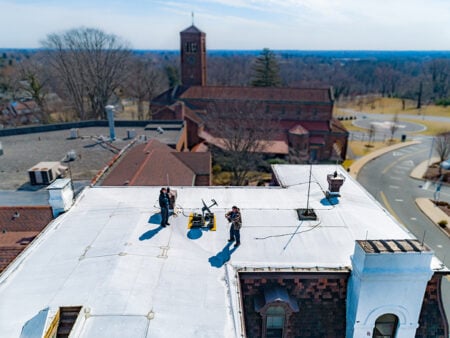Roofing | July 14, 2021
Benefits of Multi-Year Assessments on Roof Design
Roof design can be a complicated and costly affair. From rectifying severe weather damage to executing capital renewals, roof designers consider myriad factors to create the mountain of drawings and specifications required for even a small roof area. Weather data, UV exposure, rooftop units, and traffic—these all take time to consider and, of course, time is money.
So, without cutting corners, how can organizations get cost-effective roof designs, especially when they have many buildings that will require repairs or replacements over time?
The devil is in the data—or rather, a lack thereof.
What to do now about roof assessments
Performing regular roof assessments can put your organization a step ahead when it comes time to engage in roof design. Field surveyors document vital dimensions other than roof area like the height of curbs, thresholds, accessories like drains and scuppers, and various other roof penetrations.
With this data in hand, there are a few key benefits:
- A roof designer often has fewer design revisions
- They know, with confidence, how the roof needs to be designed without relying on contractor feedback while the design and specs are being reviewed.
- Fewer design revisions lead to lower design costs and, ultimately, less frustration for the client (you).
You might be saying “sure, but those assessments cost money too!” And you’re right, but for pennies on the dollar per square foot, even a large portfolio can be surveyed quickly and cost-effectively, and the result could easily offset the additional cost on a single design, let alone dozens or hundreds.

Other efficiencies available by regular assessments
Roof assessments afford additional efficiencies. While year one assessments on a portfolio are the most costly, subsequent assessments on the same buildings in future years will almost always reduce in cost.
There are plenty of lessons learned in the data collection process. Surveyors get to know their site contacts and the buildings better. They know what to look for based on the photographic documentation recorded in previous years. There’s also the opportunity for savings on travel for the field teams as they learn which clusters of buildings can be assessed in a group within a geographic area.
Examples of effective roof assessment tactics
What is the proof, you say? While we can’t name names in this case, one of our banking clients manages a portfolio of over 2,500 buildings and has seen their design and specification time for a single project go from 20-40 hours in their first year of assessments to six hours per design in year two.
Another big advantage of recurrent roof assessments is staying ahead of leaks. Field surveys can identify small problems that can be fixed with basic preventive maintenance before they become big problems that require forensic investigations and the resulting repair or replacement of the roof.
What is the bottom line?
Consistently performing regular roof assessments has a big impact on your business and its bottom line. From creating efficiencies in the design process to stopping leaks before they start, annual roof assessments can garner significant savings for organizations.
For the most impact, trust your data – and its sources. An independent roof consultant helps clients gain an understanding of the condition of their facilities and then leverage that data to generate expert, cost-effective roof designs that improve facility performance and reduce the total cost of ownership of a vital asset. Managed facility services like these can alleviate the burden of doing this level of data collection and analysis in-house, as well as bring a level of expert insight that can uncover opportunities to create efficiencies across an organization’s facility portfolio.
About Julie McDonald
Julie McDonald joined Mantis Innovation in 2021 with over 15 years of experience in the built environment. In her current role as Senior Design Consultant and Client Success Manager, Julie oversees roof and façade design for nation-wide multi-building portfolio owners. In addition to design services, McDonald specializes in design peer review and consulting, façade and roof condition assessments, forensic investigation, and building enclosure commissioning (BECx). Her background in construction management provides a unique perspective on successful execution of restoration and renovation projects.
Related Posts
Discover more content and insights from Mantis Innovation

7 Steps for Commercial Roofing Program Budget Certainty
Managing day-to-day facility operations often leaves little time for future budgeting concerns, especially for roofing assets. Commercial roofing expenditures can seem unpredictable on one's own,

Oh, Hail No: Roofing Tips for Severe Weather Season
Even a minor hailstorm can compromise your commercial roof’s integrity, making it essential to conduct a thorough inspection after any such event. According to the National Oceanic and Atmospheric

7 Key Intersections Between Architects and Roof Consultants
If you’re an architect working on large-scale commercial buildings like manufacturing plants or distribution centers or your client simply has many buildings in their portfolio, having an independent

Roof Tips for Severe Weather Season: Before & After
As an independent roofing consultant specializing in planning and managing roofing construction projects for commercial building owners and operators, I cannot stress enough the importance of
